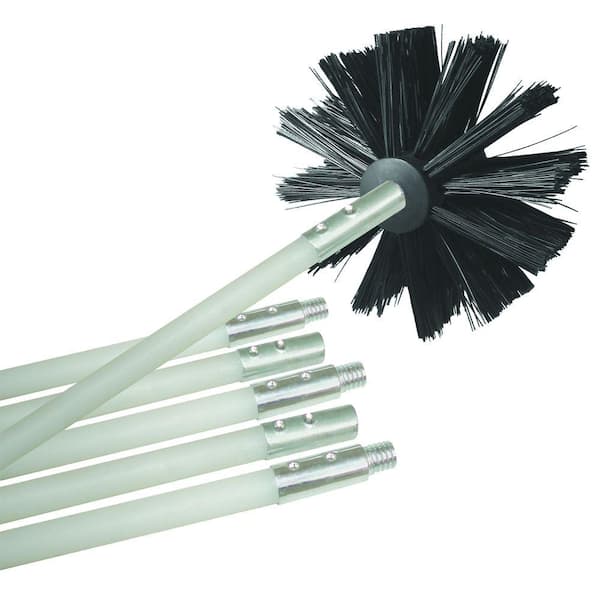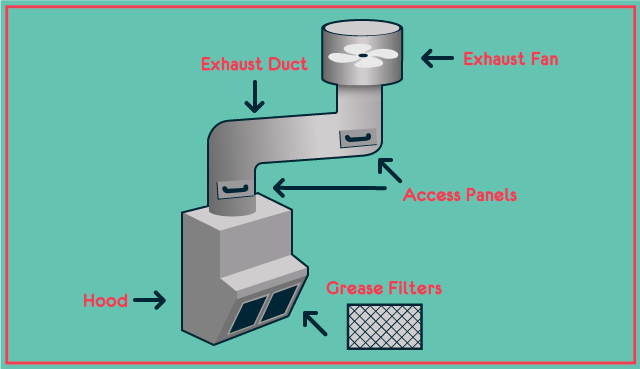To clean a home kitchen exhaust duct, first turn off power to the unit and remove any filters. Then, scrub the interior with a degreaser and damp cloth.
Ensuring the cleanliness of your home kitchen’s exhaust duct is crucial for maintaining air quality and kitchen safety. Grease and grime can accumulate in the ductwork, leading to reduced efficiency and potential fire hazards. Tackling this task involves a few steps: switching off the electrical supply, disassembling parts such as filters and covers, and using the right cleaning products.
Homeowners need to regularly address this maintenance aspect to prevent the build-up of contaminants and to prolong the lifespan of their kitchen exhaust systems. Armed with a degreaser, brushes, and cloths, even a novice can effectively clean their exhaust duct and ensure their kitchen remains a safe, clean, and pleasant environment for cooking.

Credit: www.wikihow.com
Introduction To Kitchen Exhaust Cleaning
Your kitchen exhaust duct works tirelessly to whisk away smoke and odors from your home. Clean exhaust equates to a cleaner kitchen and a more enjoyable cooking experience. Over time, grease and debris build up, potentially leading to efficiency problems and health hazards. This part of home maintenance shouldn’t be overlooked.
Importance Of Regular Exhaust Maintenance
Regular maintenance of your kitchen exhaust system is crucial. It ensures your equipment runs smoothly and extends its lifespan. Grease accumulation can lead to dangerous situations, including fire hazards. A well-maintained exhaust also means better indoor air quality.
- Prevents fire risks associated with grease buildup
- Enhances system efficiency, reducing energy costs
- Ensures consistent performance of your exhaust system
Health And Safety Benefits
Maintaining a clean exhaust system is not just about efficiency; it’s also about your health. Clean ducts minimize harmful pollutants and allergens in the air. This creates a safer cooking environment and healthier home atmosphere.
| Clean Exhaust Benefit | Health Impact |
|---|---|
| Reduces Airborne Grease | Lower risk of respiratory issues |
| Lessens Odor and Smoke | Improves overall air quality |
| Prevents Mold and Bacteria Growth | Decreases potential for food contamination |
Understanding The Components Of Your Kitchen Exhaust
Knowledge of the parts of your exhaust system is essential for effective cleaning. The main components include the hood, filters, ductwork, and fan. The hood captures smoke and grease; filters trap particles. The ductwork then channels the air out, aided by the fan.
- Inspect and clean hood regularly
- Wash or replace filters frequently
- Check ductwork for any blockages
- Ensure fan is in good working condition
Preparing For The Cleaning Process
The cleanliness of your kitchen’s exhaust duct is crucial for safety and efficiency. Before tackling this task, understanding the process is important. Proper preparation ensures a smooth cleaning experience. Let’s dive into the necessary steps.
Safety First: Tools And Precautions
Prioritizing safety is essential when cleaning your exhaust duct. Here’s how to get started:
- Turn off all power connected to the exhaust system.
- Wear protective gear: gloves, goggles, and a mask to avoid inhaling debris.
- Gather your tools: screwdriver, flashlight, and cleaning brushes.
Identifying The Type Of Ductwork In Your Home Kitchen
Different duct types require specific cleaning methods. Identify your duct type:
- Check for metal or flexible ductwork.
- Inspect the shape—round or rectangular pipes.
- Note the size and length of your ductwork.
| Duct Type | Cleaning Technique |
|---|---|
| Metal | Brush Cleaning |
| Flexible | Specialized Vacuuming |
Materials And Cleaning Agents Needed
Choosing the right materials and cleaning agents is vital for a thorough clean:
- Degreasing dish soap or baking soda for natural options.
- Brushes of varying sizes for different duct areas.
- Use a powerful vacuum cleaner for suctioning loosened debris.
Step-by-step Guide To Cleaning Your Exhaust Duct
Keeping your home kitchen exhaust duct clean is crucial for safety and efficiency. Follow this easy guide to ensure your kitchen stays smoke-free and fresh.
Step 1: Initial Inspection And Assessment
Begin with a thorough inspection of your exhaust duct. Look for grease buildup and any noticeable damage. Ensure power is off before you start.
Step 2: Removing And Cleaning The Filters
- Take out the filters from the hood.
- Soak them in hot, soapy water.
- Scrub with a non-abrasive brush.
- Rinse well and dry before reinstallation.
Step 3: Cleaning The Inside Of The Ductwork
- Access the duct by removing the cover.
- Use a specialized duct cleaning brush.
- Wipe the interior with a damp cloth.
Step 4: Scrubbing The Fan And Exterior Components
Clean the fan blades and surrounding areas carefully to avoid damage. Wipe the exterior with a suitable cleaner for shine and protection.
Step 5: Reassembling And Testing The System
After cleaning, reassemble all parts. Turn the power back on and test the system for proper operation. Listen for unusual noises.

Credit: www.nachi.org
Post-cleaning Checks And Maintenance Tips
Once you’ve tackled the grime in your home kitchen exhaust duct, the task isn’t quite finished. Post-cleaning checks and maintenance are critical to ensure your system runs efficiently. This guide will outline key steps to take after cleaning to prolong the lifespan of your exhaust system.
Ensuring Proper Ventilation And Airflow Post-cleaning
Proper ventilation is crucial for kitchen safety. After cleaning the duct, verify the following to ensure optimal performance:
- The exhaust fan operates smoothly.
- No odd noises signal blockages or damage.
- Air moves freely through the ductwork.
Scheduling Regular Cleaning And Maintenance
Regular cleaning prevents buildup and maintains air quality. Create a cleaning schedule with these factors:
| Usage Level | Cleaning Frequency |
|---|---|
| High Volume Kitchens | Every 3 months |
| Moderate Volume Kitchens | Every 6 months |
| Low Volume Kitchens | Annually |
Detecting Warning Signs Of Exhaust Malfunction
Stay alert for these signs that suggest your exhaust system needs attention:
- Unusual noises such as rattling or banging.
- Visible grease buildup on surfaces outside the duct.
- Slow smoke clearance indicates poor airflow.
Address these warning signs quickly to avoid hazards and costly repairs.
Common Challenges And Troubleshooting
Clean kitchen exhaust ducts can boost air quality and efficiency. This guide will tackle common cleaning hurdles.
Dealing With Stubborn Grease And Grime
Battling tough grease in your exhaust duct is a primary challenge. Use these steps for a thorough clean:
- Heat up the surface – Warm ducts help loosen grime.
- Apply a degreaser – Opt for a commercial-grade degreaser for best results.
- Scrub with brushes – Use a variety of brushes to reach all areas.
- Rinse well – Ensure all cleaning agents are thoroughly washed away.
Addressing Mold And Bacteria Buildup
Mold and bacteria are health hazards. Follow these tips:
- Use anti-bacterial cleaners – Select products certified to kill mold and bacteria.
- Dry ducts post-cleaning – This prevents future growth.
- Regular maintenance – Clean ducts often to avoid buildup.
Resolving Common Issues After Reassembly
Sometimes, problems appear post-cleaning. Here’s how to fix them:
| Issue | Solution |
|---|---|
| Loose parts | Re-tighten all screws and fasteners. |
| Noisy operation | Check for misaligned parts or blockages. |
| Decreased efficiency | Ensure the duct is connected correctly. |

Credit: www.homedepot.com
Frequently Asked Questions For How To Clean Home Kitchen Exhaust Duct
How Do I Clean My Kitchen Exhaust Fan At Home?
Turn off the kitchen exhaust fan. Remove the filters and soak them in hot soapy water. Use a soft brush to scrub the fan blades and interior. Rinse the filters thoroughly and let them dry before reinstalling. Regular cleaning maintains your fan’s efficiency.
How Often Should You Clean Your Kitchen Exhaust Ducts?
Kitchen exhaust ducts should be cleaned every 3-6 months, depending on usage intensity and local regulations. Frequent cleaning maintains safety and efficiency.
Do You Need To Clean Kitchen Exhaust Fan?
Yes, it’s important to clean your kitchen exhaust fan regularly to prevent grease buildup, ensure efficient operation, and reduce fire hazards. Regular maintenance improves air quality and extends the fan’s lifespan.
How Do You Clean The Inside Of A Hood Vent?
Turn off the hood and remove the filter. Soak the filter in a degreaser solution, scrub gently, rinse thoroughly, and let it dry. Wipe the interior of the hood with a degreaser spray, and clean with a non-abrasive sponge. Rinse with a damp cloth and dry.
Conclusion
Ensuring your kitchen exhaust duct remains spotless is crucial for a healthy home environment. By following the step-by-step guide provided, you’ll maintain a cleaner, safer kitchen. Regular cleaning reduces fire hazards and improves air quality. Commit to this simple routine, and enjoy the benefits of a fresh, efficient kitchen space.
